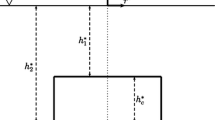Abstract
WHEN tsunamis hit a coastal area, they often cause substantial damage and loss of life at locations otherwise well protected from normal (even severe) wind-generated waves. An example of such a catastrophe took place on 12 December 1992, when an earthquake of magnitude Ms = 7.5 occurred in the eastern region of Flores Island, Indonesia1,2. One of the areas hardest hit by the resulting tsunamis was Babi, a small coastal island; two villages on the island were completely destroyed, even though both were located in sheltered areas where wave conditions are normally calm. Here we describe the results of numerical and laboratory experiments that show how, unlike wind-generated waves, tsunamis are capable of penetrating into sheltered coastal areas without significantly losing their energy. For the case of Babi Island, the original tsunami wave was split into two, with one wave propagating around each side of the island. The two waves met in the sheltered region, and the subsequent amplification of wave amplitude resulted in the destructive flow onto the beach.
Similar content being viewed by others
References
Yeh, H. et al. EOS 74, 371–373 (1993).
Yeh, H. Nature 361, 686 (1993).
Shen, M. C., Meyer, R. E. & Keller, J. B. Physics Fluids 11, 2289–2304 (1968).
Smith, R. & Sprinks, T. J. Fluid Mech. 72, 373–384 (1975).
Briggs, M. J., Synolakis, C. E. & Harkins, G. S. in Proc. Waves–Physical Numerical Modelling (eds Isaacson, M. & Quick, M.) 446–455 (Univ. British Columbia, Vancouver, Canada, 1994).
Liu, P. L.-F., Cho, Y.-S. & Fujima, K. in Proc. Waves–Physical & Numerical Modelling (eds Isaacson, M. & Quick, M.) 1031–1040 (Univ. British Columbia, Vancouver, Canada, 1994).
Russell, J. S. Rep. Br. Ass. Advmt Sci. 14, 311–390 (1844).
Synolakis, C. E. J. Fluid Mech. 185, 523–545 (1987).
Hokkaido Tsunami Survey Group EOS 74, 417 & 432 (1993).
Imamura, F. & Kikuchi, M. Geophys. Res. Lett. (in the press).
Author information
Authors and Affiliations
Rights and permissions
About this article
Cite this article
Yeh, H., Liu, P., Briggs, M. et al. Propagation and amplification of tsunamis at coastal boundaries. Nature 372, 353–355 (1994). https://doi.org/10.1038/372353a0
Received:
Accepted:
Issue Date:
DOI: https://doi.org/10.1038/372353a0
- Springer Nature Limited
This article is cited by
-
The frontal facies and sedimentation processes of a shoal-water fan delta in the Köprü Basin of southern Türkiye
Mediterranean Geoscience Reviews (2024)
-
Tsunami Occurrence 1900–2020: A Global Review, with Examples from Indonesia
Pure and Applied Geophysics (2023)
-
General Review of the Worldwide Tsunami Research
Journal of Marine Science and Application (2023)
-
Diverse tsunamigenesis triggered by the Hunga Tonga-Hunga Ha’apai eruption
Nature (2022)
-
Simulation of a tsunami-like solitary wave interacting with a piled baffle penetrated breakwater
Journal of the Brazilian Society of Mechanical Sciences and Engineering (2020)





